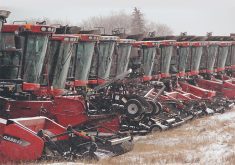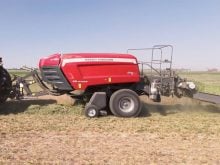Equipment companies throttle back production and inventory levels to maintain margins amidst large drop in sales
In the 1980s, Massey Ferguson’s Brantford, Ont., combine assembly plant started bleeding red ink due to management’s failure to adjust to changing market conditions. Another key problem was a bloated inventory of unsold machines sitting outside the factory doors.
All of the that led to the eventual closure of the plant and the bankruptcy of Massey Combines Corp.
Since then, executives have taken note of the importance of managing production and inventory levels during downturns in the sales cycle.
Read Also

Government, industry seek canola tariff resolution
Governments and industry continue to discuss how best to deal with Chinese tariffs on Canadian agricultural products, particularly canola.
In their third quarter conference call, executives at Agco emphasized their efforts to bring down inventory levels to maintain profitability.
“The biggest challenge for Agco this past quarter was de-stocking the dealer inventory channel,” said chief executive officer Eric Hansotia.
“Despite the significant production cut in quarter three, 2024, which was the largest year-over-year cut Agco has taken in over a decade, the market conditions have made the outlook more challenging.
“In North America, we currently have approximately four months of order coverage. Small, rural lifestyle equipment has the lowest order coverage, while bigger equipment is higher.
Agco’s sales declines were relatively consistent across the horsepower categories, with higher horsepower categories declining more in recent months.
The ag equipment market has always been cyclical. When farm commodity prices are high and farmers have cash in their pockets, demand for new machines peaks. And, of course, it falls when farmers are struggling. As a result, there’s nothing unusual about a period of sagging equipment demand.
“2024 has brought a significant contraction in the ag industry, compared to the highly profitable years farmers saw from 2021 to 2023,” Hansotia said.
“It’s not uncharacteristic compared to previous downturns. What is different this time is how we are addressing it. We’re focused on reducing inventory and cutting production faster than in prior downturns. We have been much more aggressive in reducing costs.”
According to the Association of Equipment Manufacturers, overall sales in Canada of farm tractors have fallen more than 16 per cent, even though four-wheel drive tractor sales are up.
However, four-wheel drive machines represent only a small number of overall tractor sales. Combine sales, too, have dropped by more than 11 per cent.
Other parts of the world have seen comparable slumps in sales volumes.
To cope, Agco reduced the number of production hours in its plants by 35 per cent in the third quarter of 2024 because by the end of September, Agco’s net global sales numbers had slumped by US$2.8 billion compared to the previous year.
Over at John Deere, things sound similar, and the company projects a further slow-down next year.
“(For fiscal year 2025), we expect industry sales of large ag equipment in the U.S. and Canada to decline approximately 30 per cent,” Josh Rohleder, manager of investor communications, said in a fourth quarter earnings call.
“Looking ahead to 2025, we expect continued contractions of ag markets globally.”
At CNH Industrial, the parent company of Case IH and New Holland, third quarter consolidated revenue fell by 22 per cent compared to the same time last year.
John Deere, too, has focused on aggressive production cuts and early inventory reduction to maintain a healthy operating margin. Despite a 38 per cent fall in net sales in its production and precision ag segment compared to the same time last year, its profit margins remained one of the highest in the industry.
“John Deere finished the year with better than expected fourth quarter that included 13.1 per cent margins for equipment operations,” said Rohleder.
“Full year operating margins came in at 18.2 per cent.
“Our production decreased in the third quarter by approximately 35 per cent, which was 19 per cent more than we anticipated. Nevertheless, we ended the year with over seven billion in net income.”
The biggest production declines occurred in South and North America.
To further reduce inventories, Deere is planning to cut back even more. The company’s new 2024 plan now reflects a 25 per cent year-over-year reduction in operating hours at its facilities. It expects in North and South America 2025 production levels will be less than retail demand in the first part of 2025.
“Our goal for 2024 was to under-produce large ag retail by high single digits,” Rohleder said.
“In North America, we reached our goal of targeted inventory levels on most of our key products. In 220 horsepower and larger tractors, we reduced inventory by nearly 50 per cent year over year. Inventory levels for 220 horsepower and larger tractors have only been this low twice.”


















